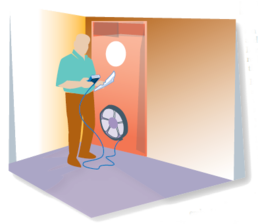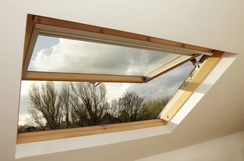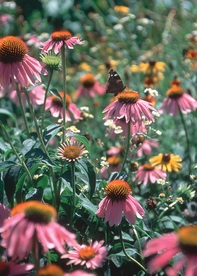|
More intense and frequent storms, extreme heat and
humidity, flooding, changes in rainfall patterns, more power outages--these trends are consistent with what we can expect with climate change and are already happening in Minnesota. They have a big impact on our communities, neighborhoods, families, and homes.
In a changing climate, a good goal is to have a home that is
able to withstand weather and temperature extremes. Fortunately, there are many things
that we can do to prepare our homes for
these changes. An added benefit is that many of these actions also help reduce the biggest contributor
to climate change: greenhouse gas emissions!
 Schedule an energy assessment
The burning of fossil fuels,such as coal and natural gas, to create
electricity or to heat buildings creates climate-altering greenhouse
gas emissions. Reducing our energy use not only saves us money and conserves
resources--it’s also an effective way to cut our emissions.
A
home energy assessment by a professionally trained auditor can help pinpoint
home performance issues and offer solutions that can save you money and reduce your home’s
energy use and carbon
footprint. Check with your utility
company to see if they provide free or subsidized energy audits, or contact the
Minnesota Building Performance Association for suggestions regarding energy auditors.
Insulate and seal
A home that is well air-sealed and insulated saves you energy and money while increasing your comfort. During power outages, homes that are properly sealed may stay comfortably warm or cool for longer. They are also much more climate-friendly than poorly sealed homes, because they require
less energy to heat and cool. Home Envelope, a publication of the Minnesota Department of Commerce Division of Energy Resources, provides clear, practical recommendations and information on home insulation, air-sealing, and more.
|
 Ventilate naturally
During mild weather, explore ways to increase natural ventilation. First, determine how and where prevailing winds are
blowing--refer to the NOAA Wind Map for guidance. Next,
experiment with opening windows and doors
throughout the house to find out what gives you the best
air flow. Add strategically placed fans to help move the air
from room to room.
See Cooling Your Home with Fans and Ventilation from the U.S. Department of Energy for more suggestions.
Maintain or upgrade your furnace, A/C, and water heater
To function best,
furnaces, air conditioners, water heaters, and similar systems need
regular maintenance. Information on maintaining heating and air
conditioning systems is available at energy.gov/energysaver. If shopping for new heating or cooling systems, look for ones that have
the Energy
Star label. The label certifies that the appliance has met U.S. EPA standards
for energy and water use. Consider furnaces, water heaters or other systems that can be
wall mounted or elevated in areas where unwanted water might
enter.
|
Conserve water
A lot of energy is needed to pump, treat, and heat
water. By conserving water and thus energy, we can reduce greenhouse gas
emissions. Using water more efficiently and not wasting it also helps to
ensure that it’s available when we most need it. Here are some effective ways
to save water:
- Fix
leaky toilets and fixtures, including leaks in irrigation systems. (Leaks
can account for as much as 14% or more of a household's water use!)
- Only
run full loads in the dishwasher and washing machine.
- Replace
inefficient toilets and fixtures with water efficient ones. When shopping,
look for the WaterSense
label, which ensures that the product has met high standards for water
efficiency and performance by the U.S. EPA.
 Keep water out of your basement
Heavier and more frequent rain events mean more stormwater
run-off and more potential for storm-drain backups, erosion, water pollution,
flooding, and water in homes.
- Keep gutters cleaned to help direct water away from the foundation.
If your gutter system is not big enough to handle heavy rain, consider replacing with over-sized gutters.
- Place rain-barrels at downspouts. A 1-inch rain on a 1,000 sq.
foot roof will produce over 600 gallons of water! Use the collected
rainwater to irrigate your lawn or garden. Empty barrels often to prevent overflow!
- Create a rain garden to collect storm-water that might otherwise find its way into your home or flood your lawn or street.
- Watch for water pooling close to the home. Landscape through sloping or other means
to redirect water away from the foundation.
- Limit/replace surfaces like asphalt and concrete (which
don’t absorb water) with permeable (porous, absorbent) ones. Like rain gardens, permeable pavers and
porous asphalt and concrete allow water to soak in, helping to replenish groundwater, rather than draining into storm sewers or streams and lakes
where it can cause flooding and contamination.
|
 Replace turf with native plants and grasses
Native plants typically need less water to thrive than do
non-natives and can often handle drought and other weather extremes more
effectively. An added benefit of native
plants is that many have deeper root systems which can absorb and retain water that might otherwise become storm runoff. They also provide habitat for birds, butterflies and other
pollinators as well as local wildlife.
Plant a tree
Trees are great options for fighting climate change -- one tree
can absorb a ton of CO2 over its lifetime! Trees are also great at absorbing
rain water. See livinggreen.org/trees for information and guidance on landscaping with trees. An excellent resource on landscaping for energy savings can be found at Energy.Gov/Landscaping.
|
Sustainability Film Series: A Place at the Table
The 5th annual Sustainability Film Series continues!
March 5, 7 p.m.
Free with museum
admission
Bell Museum of Natural History is located at the corner of University Ave. & 17th
Ave. SE in Minneapolis, on the University of Minnesota campus.
Fifty million
people in the U.S.--one in four children--don't know where their next
meal is coming from. Directors Kristi Jacobson and Lori Silverbush
examine the issue of hunger in America through the lens of three people
struggling with food insecurity; ultimately showing that making healthy
food available and affordable is in the best interest of us all. Refreshments served at 6:30 p.m.
SPRING INTO GREEN
Resource + Craft Event, Saturday, March 14, 2015, 10 a.m.- 5 p.m. Midtown Global Market
$1 Donation accepted at the doors
Sponsored by Do it Green! MN and the Midtown Global Market
Come learn about resources for greener living, conversation cafes, and local and eco-craft vendors. Music and kids activities included.
Experts
on different topics including food, energy, transportation and more
will be on hand to discuss environmental issues and to give you ideas on
how to address these in your community through education, displays,
demos, and activities for this coming April's Earth Month.
Event partners include the Alliance for Sustainability and Hennepin County Environmental Services.
Waste Not: Breaking Down the Food Equation
Saturday, March 28, 3 p.m.
Ridgedale Library, 12601 Ridgedale Dr, Minnetonka, Minnesota 55305
Created by students from Pacific Lutheran University's
MediaLab (Tacoma, Washington), this documentary investigates how and
why food is wasted. The 30-minute film will be followed by a discussion
of food waste and the efforts being taken to reduce this
unnecessary waste.
Amanda Brasgalla, Senior Producer, will be present to discuss the
project. She is a fourth-year Communication major with an emphasis in
Conflict Management and Global Peacebuilding.
This event is open to all -- PLU alums, friends and family of the
university, perspective students, and members of the public interested
in learning more about how you can address food waste in your own life.
To RSVP, click here. Learn more about the documentary at http://wastenotdoc.weebly.com/.
Thank you for subscribing to Living Green 365. This newsletter is a publication of the Minnesota Pollution Control Agency. Send questions or comments about living green to the address
below.
Sincerely,
Erin Barnes-Driscoll and the Living Green Team
livinggreen365.pca@state.mn.us
|